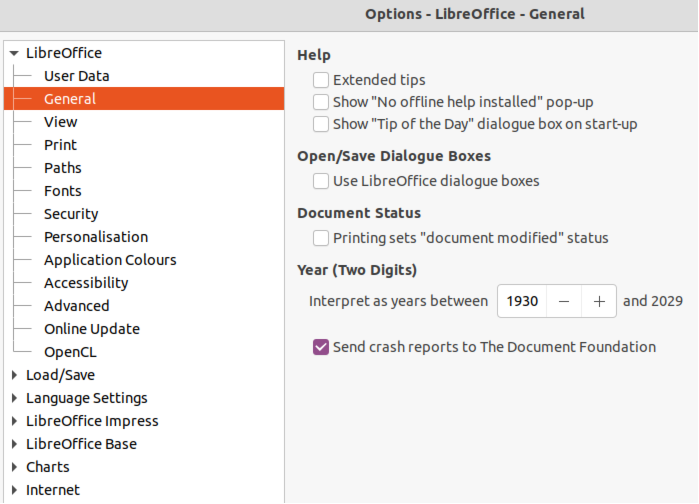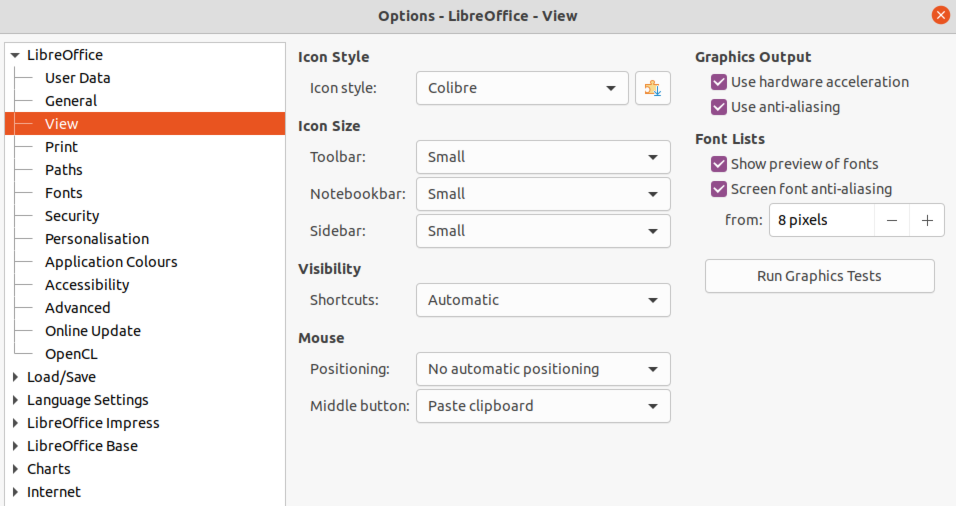

Impress Guide 7.4
Preface
This document is Copyright © 2022 by the LibreOffice Documentation Team. Contributors are listed below. You may distribute it and/or modify it under the terms of either the GNU General Public License (https://www.gnu.org/licenses/gpl.html), version 3 or later, or the Creative Commons Attribution License (https://creativecommons.org/licenses/by/4.0/), version 4.0 or later.
All trademarks within this guide belong to their legitimate owners.
Contributors for this edition:
Peter Schofield
Kees Kriek
Contributors for previous editions:
Peter Schofield
Kees Kriek
Claire Wood
Jean Hollis Weber
Vasudev Narayanan
Rachel Kartch
Please direct any comments or suggestions about this document to the Documentation Team mailing list: loguides@community.documentfoundation.org.
Note
Everything sent to a mailing list, including email addresses and any other personal information that is written in the message, is publicly archived and cannot be deleted.
Published October 2022. Based on LibreOffice 7.4 Community.
Other versions of LibreOffice may differ in appearance and functionality.
Anyone who wants to quickly acquire knowledge on LibreOffice Impress and is new to presentation software, or may be familiar with another office suite, will find this user guide very useful.
LibreOffice is an open-source office productivity software suite containing capabilities for word processing, spreadsheets, presentations, graphics, databases, and formula editing. LibreOffice Impress is used as a visual aid and is the presentations application for LibreOffice. It is compatible with a wide range of formats like Microsoft PowerPoint (.ppt, .pptx). Presentations can be exported in several file formats, for example, PDF, HTML, and numerous graphic formats.
This user guide introduces the main features of Impress, the presentations (slide show) component of LibreOffice. Impress slides can contain text, bulleted and numbered lists, tables, charts, clip art, and other objects. Also, Impress comes with prepackaged styles, slide backgrounds, and templates to help in creating presentations.
For a detailed list of requirements and operating systems supported, see the LibreOffice website, https://www.libreoffice.org/get-help/system-requirements/.
Versions of LibreOffice for Windows, Linux, and macOS are freely available and can be downloaded from https://www.libreoffice.org/download. Linux users will also find LibreOffice included free in many of the latest distributions.
Portable and other versions of LibreOffice are listed on the download page. Linux, Vanilla, and other versions may differ in a few features from the descriptions in this user guide.
Information on installing and setting up LibreOffice on the various supported operating systems is given here: https://www.libreoffice.org/get-help/install-howto/.
To change the default settings (options) in LibreOffice to match the required preferences, go to Tools > Options on the Menu bar (LibreOffice > Preferences in macOS).
Tip
Many settings are intended for power users and programmers. If it is difficult to understand what an option does, LibreOffice recommended leaving the option on its default setting unless instructions in this user guide recommend changing the setting.
Settings are described in LibreOffice Help and the Getting Started Guide. These two sources provide information on how to customize menus, toolbars, and keyboard shortcuts in LibreOffice Impress, add new menus and toolbars, and assign macros to events. Some settings of particular interest to Impress users are also covered in Chapter 11, Setting Up and Customizing Impress.
Functionality can be added to LibreOffice with extensions and add-ons. Several extensions are installed with the program and other extensions from the official extensions repository, https://extensions.libreoffice.org/ or from other sources. See the Getting Started Guide for more information on installing extensions and add-ons.
LibreOffice comes with an extensive Help system and this can be used as the first line of support. Windows and Linux users can choose to download and install the offline Help for use when not connected to the Internet. Offline Help is installed with the MacOS version of LibreOffice.
To display the LibreOffice Help, press F1 or go to Help > LibreOffice Help on the Menu bar. If the offline help is not installed on a computer, but connected to the Internet, a dialog opens giving the option to Read Help Online. Select this option and the default web browser opens at the LibreOffice online help pages in the LibreOffice website.
The Help menu also includes links to other LibreOffice information and support facilities.
What's This?
User Guides
Show Tip of the Day
Search Commands
Get Help Online
Send Feedback
Restart in Safe Mode
Get Involved
Donate to LibreOffice
License Information
Check for Updates
About LibreOffice
The LibreOffice community not only develops software, but provides free, volunteer-based support. See Table 1 and the web page https://www.libreoffice.org/get-help/. For comprehensive online support from the community, look at mailing lists and the Ask LibreOffice website, https://ask.libreoffice.org/en/questions/. Other user websites also offer free tips and tutorials.
Table 1: Free support for LibreOffice users
|
Free LibreOffice support |
|
|
FAQs |
Answers to frequently asked questions |
|
Mailing lists |
Free community support is provided by a network of experienced users |
|
Questions & Answers and |
Free community assistance is provided in a Question & Answer formatted web service. Search similar topics or open a new one in https://ask.libreoffice.org/en/questions The service is available in several other languages; just replace /en/ with de, es, fr, ja, ko, nl, pt, tr, and many others in the web address above. |
|
Native language support |
The LibreOffice website in various languages Mailing lists for native languages Information about social networking |
|
Accessibility options |
Information about available accessibility options. https://www.libreoffice.org/get-help/accessibility/ |
|
OpenOffice Forum |
Another forum that provides support for LibreOffice, among other open source office suites. https://forum.openoffice.org/en/forum/ |
Support and training is available through service contracts from a vendor or consulting firm specializing in LibreOffice. For information about certified professional support, see The Document Foundation website: https://www.documentfoundation.org/gethelp/support/.
LibreOffice runs on Windows, Linux, and macOS operating systems, each of which has several versions and can be customized by users (fonts, colors, themes, window managers). The illustrations in this guide were taken from a variety of computers and operating systems. Therefore, some illustrations will not look exactly like what is seen on a computer display.
Also, some of the dialogs may differ because of the settings selected in LibreOffice. Either use dialogs from the computer system (default) or dialogs provided by LibreOffice. To change to using LibreOffice dialogs:
Figure 1: Options LibreOffice dialog - General page

Figure 2: Options LibreOffice dialog - View page

1) On Linux and Windows operating systems, go to Tools > Options > LibreOffice > General (macOS LibreOffice > Preferences > LibreOffice > General) on the Menu bar to open the dialog for general options.
2) Select Use LibreOffice dialogs in Open/Save Dialog Boxes to display the LibreOffice dialogs on a computer display, as shown in Figure 1.
3) Click OK to save the settings and close the dialog.
The LibreOffice community has created icons for several icon sets, including Breeze, Colibre, Elementary, Sifr, and Tango. Each user can select a preferred set. The icons used to illustrate some of the many tools available in LibreOffice may differ from the ones used in this guide. The icons in this user guide have been taken from a LibreOffice installation that has been set to display the Colibre set of icons.
Change the icon set used in a LibreOffice installation as follows:
1) On Linux and Windows operating systems, go to Tools > Options > LibreOffice > View (macOS LibreOffice > Preferences > LibreOffice > View) on the Menu bar to open the dialog for view options.
2) In Icon Style select Colibre from the options available in the drop down list as shown in Figure 2.
3) In Icon Size, select Small from the drop down lists for Toolbar, Notebookbar and Sidebar, as shown in Figure 2.
4) Click OK to save the settings and close the dialog.
Note
Some Linux operating systems, for example Ubuntu, include LibreOffice as part of the installation and may not include the Colibre icon set. This icon set can be downloaded from the software repository for the Linux operating system being used.
Some keystrokes and menu items are different on macOS from those used in Windows and Linux. Table 2 below gives some common substitutions used in this user guide. For more information on keyboard shortcuts, see LibreOffice help and Appendix A, Keyboard Shortcuts in this user guide.
Table 2: Example of macOS keyboard shortcuts
|
Windows or Linux |
macOS equivalent |
Effect |
|
Tools > Options on Menu bar |
LibreOffice > Preferences on Menu bar |
Access to setup options |
|
Right-click |
Ctrl+click and/or right-click depending on computer setup |
Opens a context menu |
|
Ctrl or Control |
⌘ and/or Cmd or Command, depending on keyboard |
|
|
Alt |
⌥ and/or Alt or Option depending on keyboard |
Used with other keys |
|
F11 |
⌘+T |
Open the Styles deck in the Sidebar |
This user guide was written by volunteers from the LibreOffice community. Profits from sales of the printed edition will be used to benefit the community.
How is LibreOffice licensed?
May I distribute LibreOffice to anyone?
May I sell it?
May I use it in my business?
How many computers may I install it on?
Is LibreOffice available in my language?
How can you make it for free?
I am writing a software application. May I use programming code from LibreOffice in my program?
Why do I need Java to run LibreOffice? Is it written in Java?
Note
If the LibreOffice features that require Java are to be used, it is important that the correct 32-bit or 64-bit edition matches the installed version of LibreOffice. For more information, see the Getting Started Guide. If Java is not to be used, nearly all of the LibreOffice features can still be used.
How can I contribute to LibreOffice?
May I distribute the PDF of this user guide, or print and sell copies?
The LibreOffice 7.4 Release Notes are available at this link https://wiki.documentfoundation.org/ReleaseNotes/7.4.
Also at this link, the release notes for earlier versions of LibreOffice are located giving more information on the features that are included in LibreOffice.